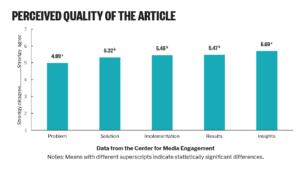
You’ve probably heard the complaint: the news is just too negative. You can’t stop covering the bad stories, but you can give readers some of what they want – positive news coverage that focuses on solutions, not just the problem.
We already know that solutions journalism can make people feel more informed, optimistic, and engaged in an issue. But what is it about solutions journalism that makes them feel this way?
Components of Solutions Journalism
To find the answer, the Center for Media Engagement broke down solutions journalism into five core components, based on work from the Gates Foundation and Solutions Journalism Network:
- Problem: The causes and symptoms of the issue,
- Solution: The replicable ideas tied to solving the problem,
- Implementation: The how-to details of putting the solution into action,
- Results: The progress, data-based or anecdotal, made in working toward a solution, and
- Insights: The teachable, big-picture lessons that can be learned beyond one particular solution or situation.
The idea was to figure out which of these components had the greatest effect on readers. When you boil it all down, the answer is that the more information you can provide, the better.
Findings
Articles with all five components are better for both the newsroom and the reader (more on that in a moment). However, some of our research suggests that adding components 3 to 5 only makes a difference if you invest in in-depth reporting on components 1 and 2. Essentially, it’s important for journalists to take the time to fully explain the problem and solution before exploring the other components.
Improved perceptions of article quality
Including all five components of solutions journalism can improve the way readers perceive your work. Readers rated articles with all five components as the highest quality among the articles.
Increased intentions to engage
Fully exploring solutions journalism can help your engagement numbers. Readers of articles with all five components were more likely to say they would “like” a similar article on Facebook and would read additional articles about the issue compared to those who just read about a problem.
Increased interest in and knowledge about the issue
Not only can solutions journalism help your newsroom succeed, but it can also help your readers learn. Those who were given an article with all five components were more likely to say the article increased their interest in the issue and more likely to believe there were ways to address the problem than those who just read about a problem and solution. They also felt more knowledgeable about the issue if it included results and insights.
Boosted positivity
Not surprisingly, solutions journalism is a good way to help counter the feeling that news is too negative. Articles that included components beyond the problem and solution proved to be a mood booster.
Bottom Line for Newsrooms
Newsrooms should make the effort to explore all five components of solutions journalism. Granted, articles containing all five elements are longer. But giving readers an in-depth view of a story can improve how they view the quality of your coverage and make them want to get involved in finding a solution to the problem. Solutions journalism benefits both newsrooms and readers alike.
You can read the full report here.




